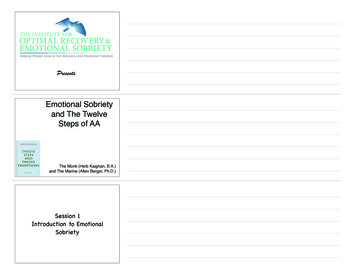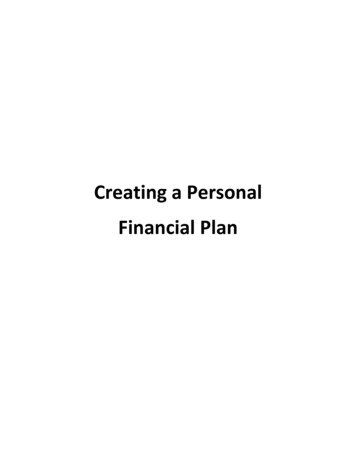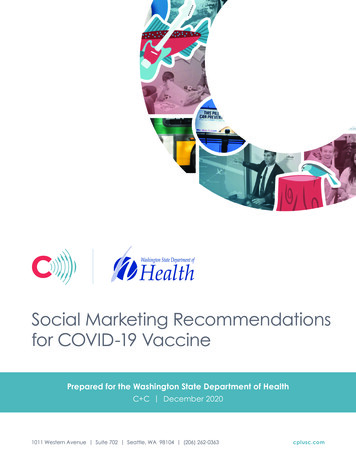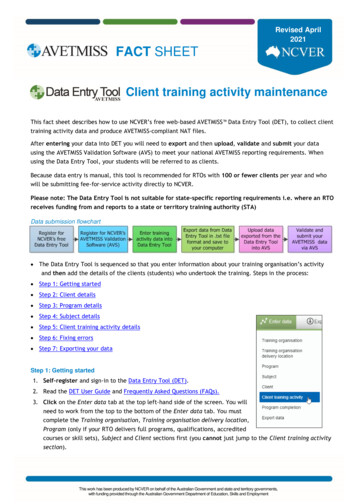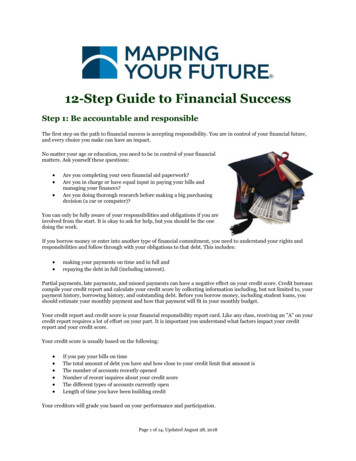
Transcription
12-Step Guide to Financial SuccessStep 1: Be accountable and responsibleThe first step on the path to financial success is accepting responsibility. You are in control of your financial future,and every choice you make can have an impact.No matter your age or education, you need to be in control of your financialmatters. Ask yourself these questions: Are you completing your own financial aid paperwork?Are you in charge or have equal input in paying your bills andmanaging your finances?Are you doing thorough research before making a big purchasingdecision (a car or computer)?You can only be fully aware of your responsibilities and obligations if you areinvolved from the start. It is okay to ask for help, but you should be the onedoing the work.If you borrow money or enter into another type of financial commitment, you need to understand your rights andresponsibilities and follow through with your obligations to that debt. This includes: making your payments on time and in full andrepaying the debt in full (including interest).Partial payments, late payments, and missed payments can have a negative effect on your credit score. Credit bureauscompile your credit report and calculate your credit score by collecting information including, but not limited to, yourpayment history, borrowing history, and outstanding debt. Before you borrow money, including student loans, youshould estimate your monthly payment and how that payment will fit in your monthly budget.Your credit report and credit score is your financial responsibility report card. Like any class, receiving an "A" on yourcredit report requires a lot of effort on your part. It is important you understand what factors impact your creditreport and your credit score.Your credit score is usually based on the following: If you pay your bills on timeThe total amount of debt you have and how close to your credit limit that amount isThe number of accounts recently openedNumber of recent inquires about your credit scoreThe different types of accounts currently openLength of time you have been building creditYour creditors will grade you based on your performance and participation.Page 1 of 14, Updated August 28, 2018
Step 2: Plot your courseStep two on the path to financial success involves planning. It is impossible to effectively manage your finances if youdon't know how much money you have available to spend or have a plan on how you want to spend, invest, and save.You need to create a road map by defining your financial goals.Three essential keys to setting goals: Be specific – define what you want to achieve and when. Goals can be short term (a few days, months, or ayear) and long term (five, 10, or 15 years).Be realistic – make certain your goals are attainable. Setting unattainable goals will only lead todisappointment when they are not achieved.Write them down – keep records of your goals and mark off key milestones as you achieve them. Refer tothis information from time to time. Writing down goals, reviewing them, and recording your progress canmotivate you.After you have identified your goals, map out how you are going to achieve them. There are many questions that mayneed to be answered. Here are a few to get you started: How much income do I have available? How much will I need to achieve this goal?Are there any other obligations or goals I need to finish first?If I cannot buy the item with cash, how much money is needed for a down payment?When putting together your plan, make certain you are as thorough as possible. The better prepared you are, theeasier you can adapt as life changes.Step 3: Understand your incomeYou've just been offered a starting position with a local firm. They've offered you 40 hours per week starting at 15 perhour, which means you'll be taking home 600 (40 X 15) dollars a week. True or False?FalseThere are numerous deductions taken from your gross pay (hours multiplied by your hourly wage). Your net payis the amount of money you receive after deductions are taken.Standard deductions: Federal income tax – tax you pay the federal government.Social Security – a contribution toward Social Security retirement benefits.Medicare – a contribution toward Medicare benefits.The amount of federal taxes withheld will depend on the amount of your pay and the number of exemptions you claimon your W-4 (the form you complete when you start your job). An exemption is a deduction that allows a certainamount of income to be excluded to avoid or reduce taxation. Exemptions may be for the individual and familymembers who the individual supports.Page 2 of 14, Updated August 28, 2018
Other deductions: State taxes – Many states withhold state income taxes.Additional retirement contributions – Voluntary contributions,such as 401K, 403b, in addition to Social SecurityHealth insurance – Some employers will pay all or part of anemployee’s health insurance costs. Typically, the employee will have tocontribute toward those costs, which may include covering familymembers.Cafeteria plan benefits – Many employers may allow you to have aportion your pay set aside for child care and/or health costs. Thesewithholdings typically are pre-taxed.Wage garnishments – Money automatically deducted as a result of a legal decision, such as defaulting onyour federal student loan.Other – Agreed automatic withholdings (parking and other fees associated with employment).Review your paystubs when you receive them. Make sure you understand each deduction, and that proper amountsare deducted. Report any discrepancies to your employer immediately. If you have questions, meet with a HumanResources representative to go over the details of your company's benefits or talk with your employer if your companydoesn't have a human resources department.Step 4: Open a checking accountA checking account is a secure place to keep your money and helps you track your money. A checking account createsa paper trail which assists you in knowing how much money is available to spend.Prior to opening a checking account, thoroughly research to find a bank, credit union, or other type of financialinstitution that provides an account that best suits your needs.Three common types of accounts: Standard: Includes a set monthly fee with no check charge. There is no monthly fee if you maintain aminimum balance.Special: Service fees are charged for returned checks for insufficient funds, the creation of money orders,cashier's checks, check orders, and sometimes for the transfer of funds.Interest-bearing account: Interest is paid to your account if a minimum daily balance is maintainedduring the month.Some banks offer "free" checking accounts or other enticements specificallytargeted to students. To avoid hidden fees, make certain to read all of thefine print. Be sure the account really is free.The check register is an important element of your checking account.Record all transactions including all deposits, withdrawals, and deductions.Here are some examples: DepositsChecks writtenScheduled automatic withdrawals or bank feesATM or debit card transactionsPage 3 of 14, Updated August 28, 2018
In addition to writing checks, ATM (automatic teller machine) and debit cards are common tools used to withdrawmoney from your account. They may also allow you to deposit, transfer, and verify funds in your account. ATM cardsare strictly for use at automatic teller machines, but debit cards also can be used at most merchants to makepurchases.Tips for ATM and debit card usage: Never share your PIN number.Always record your transactions.Record additional fees charged for using an out-of-network ATM (try to avoid them).Be aware that transactions may not always be automatically reflected in your account balance, for some, itmay take two to three days.When given the option to use your card as a credit or debit, select credit where possible. This protects yourpurchases in the event of fraud, whereas debit may not.Spending more money than you have in your checking account is called an overdraft. Avoid overdrafts at all costs(no pun intended!), as you will have to pay overdraft fees! Overdraft fees are approximately 30 per item (and may bemore depending on the bank or institution). One check or ATM/Debit withdrawal for 5 could end up costing you 35or more, especially if it causes other transactions to overdraft as well. Never spend more money than you have in youraccount.If your bank offers online banking, review your account at least once a week. This will not only help you keep track ofhow much money you have, but also will allow you to quickly identify errors or possible fraudulent transactions.Reconciling (balancing) your checkbook every month is critical to successful checking account management. Keepingyour checkbook balanced will: help you avoid overdrafts,make you aware of where you are spending your money, andassist in locating any mistakes that you or the bank make.To balance your checking account book, use Mapping Your Future’s free calculator atmappingyourfuture.org/money/checkbook.cfm.Step 5: Start saving and investingEstablishing a savings account is the best way to help you financially deal withthe uncertainties of life (such as job loss or medical expenses) and achieve yourfinancial dreams (pay for college, purchase a car, travel, or save for retirement).Remember to pay yourself first! Depositing money into a savings account shouldtake priority over any additional spending. Here are some ideas to help: As you pay your monthly bills, set money aside to deposit into yoursavings.Ask your bank to automatically transfer money from your checking toyour savings once or twice a month.Request a direct deposit from your employer for a portion of your paycheck to be deposited into your savingsaccount.Make sure you are not spending more than you earn and that you are able to save money every month. Ultimately,you should maintain a balance that would cover six to 12 months of your expenses. Small amounts add up and make adifference over time.A savings account with compounding interest will help your account balance grow. The interest that you earn on yoursavings account is added to the total balance of your account, which will result in more money earned.Page 4 of 14, Updated August 28, 2018
The chart below demonstrates how your money can grow over time in a savings account:Interest RateMonthlyDepositAmount in savings account after:1 Year2 Years3 Years4 years0% 20 240 480 720 9600% 40 480 960 1,440 1,9200% 60 720 1,440 2,160 2,8800% 100 1,200 2,400 3,600 4,8000% 200 2,400 4,800 7,200 9,6002% 20 242.21 489.31 741.40 998.582% 40 484.42 978.63 1,482.80 1,997.162% 60 726.64 1,467.94 2,224.21 2,995.742% 100 1,211.06 2,446.57 3,707.01 4,992.902% 200 2,422.12 4,893.13 7,414.02 9,985.795% 20 245.58 503.72 775.07 1,060.305% 40 491.15 1,007.44 1,550.13 2,120.605% 60 736.73 1,511.16 2,325.20 3,180.895% 100 1,227.89 2,518.59 3,875.53 5,301.495% 200 2,455.77 5,037.18 7,750.67 10,602.98Invest wiselyInvesting is a great way to have your money work for you, but comes with risk. Before you start investing, it isimportant to understand the different options and the risks involved. Don't think you are too young to invest. Thebest time to invest is when you are young, as you have more time for your investments to grow and weather the upsand downs of the stock market and economy.Different investment options offer different rates of return. Generally, the higher rate of return has higher the chanceof losing your investment (the lower the rate of return, the lower the chance of losing your investment dollars).Types of investmentsDescriptionSavings accountsProvide a safe way to save money and draw interest on the balance.Money market accountsDraw a higher interest rate than a traditional savings account, but usually have aminimum balance requirement.Certificate of Deposit (CD)Funds are placed into a CD for a fixed period of time and fixed interest rate.StockPurchasing stocks allows you to buy part ownership of a company and you makemoney or lose money as the value of the stock increase or decreases depending onthe stock market.BondsLoan money to a government or company, who issues you a bond promising torepay you at a fixed rate of interest on a specific dateMutual fundsInvest in a professional managed fund that can include a combination of stocks andbonds with various risk factors.Retirement accountsVarious options are available to invest for your future retirement needs. Keep inmind that many employers offer a 401k, 403b, or other type of retirement programand may provide a match to your contributions. Take advantage of a contributionmatch any current or future employer provides. This match is provided as part ofyour compensation package and will help you meet your investment goals.Page 5 of 14, Updated August 28, 2018
Make your investing plan by: Setting your goalsLearning about investing and your optionsDetermining if you need a stock brokerMaking a planSticking to your plan-don't change your strategy on a daily basis.Step 6: Create a budgetEstablishing a budget and monitoring it on a regular basis is not easy, but it is the best way to ensure you are incontrol of your financial future. Think of your budget as a spending plan. It helps you be aware of how much moneyyou have, where it needs to go, and how much, if any, is left over.Follow these steps to create your budget:1.Determine your income.a.b.2.Determine your expenses.a.b.c.d.3.Review your paystubs and your check register to identify how much money you are earning.Do not include overtime pay. It is not considered regular income.Review your checkbook register, store receipts, and billing statements to see where your money isgoing.i. Fixed expenses include items such as a rent, auto, or student loans that must be paid eachmonth. These expenses typically are the same amount.ii. Flexible expenses include items such as food, clothing, and entertainment that vary frommonth to month.List each of your expenses separately. Do not group things such as eating out and groceries togetherand list them as food. Do not add cable, cell phone, power, and water together and list them asutilities. If you have to cut expenses, you’ll want to consider each expense individually.Be certain to include expenses that are billed quarterly, semi-annually, or annually, such as taxes orinsurance.Always remember that saving must be first on your list of expenses.Create a budget.a.b.c.A budget should meet your "needs" first, then the “wants” that you can afford.Your expenses should be less than or equal to your total income.If your income is not enough to cover your expenses, adjust your budget (your spending) bydeciding which expenses can be reduced.Choose a tool that works for you. Make sure you choose a tool that is easy enough that you won't get discouragedfrom using it. Each person has their own style, so be sure to pick the best one for you. If the calculator above doesn'twork for you, here are some other ideas:Page 6 of 14, Updated August 28, 2018
Mapping Your Future’s free and easy budget lator.cfmSimple handwritten notebooksMicrosoft Excel spreadsheetsMoney management computer programs or online toolsReview your budget. Be certain to review your budget regularly. Does the budget meet your needs and help youachieve your goals? If not, make some adjustments or create a new budget that better meets your needs.Budgeting Tip: If you are not sure where your money is going, carry a small notebook with you for 30 days andwrite down each cash expense. This will enlighten you as to what you are spending.Step 7: Borrow smartAt some point you may need to borrow money (take out a loan). It is imperative that you borrow smart if you want tomaintain your financial stability.Loans are most commonly used for the following: HomesAutomobilesEducationWhen considering the purchase of any item, consider these questions: "Do I really need this item?" "Would I be betteroff to save for this item in the future and pay cash?"With any loan, you should consider several factors, including the interest rate, additional fees, and down payment. The interest rate is the amount you are charged to borrow money. When money is borrowed, you mustrepay the principal (the dollar amount you borrow), and the interest that accrues during the life of the loan.The higher the interest rate, the more you will pay. Interest rates may be fixed or variable.o Fixed interest rates will remain the same throughout the term of the loan.o Variable interest rates will periodically adjust as a result of current market conditions.For some loans, additional fees may be charged. For example, some loans have closing costs. Auto loansmay include additional insurance or warranty costs. Student loans may have origination and/or default fees.Prior to accepting a loan, make sure you understand the payment requirements and all of the fees associatedwith the loan. It is important to know exactly how much you will be expected to pay.Down payments are large payment amounts paid toward your purchase. Down payments minimize theamount you have to borrow. The more money paid up front toward the purchase, the more money you willsave over the life of the loan. For most large purchases, it is recommended that you pay at least 20 percentfor a down payment.Your monthly payment must fit into your budget. The new monthly payment must not cause yourexpenses to exceed your income.Page 7 of 14, Updated August 28, 2018
Here are some additional guidelines to help you determine whether or not to borrow money: Housing expenses should not exceed 33 percent of your gross income. Many lending institutions look at thisfactor in determining your loan eligibility. Percentages may vary slightly between lenders.Loan installment payments which include auto and student loans, credit cards, etc. should not exceed acombined total of 20 percent of your gross income.Remember to save money and have at least 6–12 months of emergency savings.When making a decision to make a purchase, add the new payment amount into your monthly budget. Consider theguidelines above when inserting the figure for the new purchase. If the amount of the payment for the purchaseexceeds the recommendations, does not allow you to save money, or causes your monthly expenses to exceed yourmonthly income, you may want to postpone your purchase until you have more money saved, find a more affordableand comparable item, or pay off other debt.For more information about your student loan debt: You may access the National Student Loan Data System(NSLDS) on line at www.nslds.ed.gov or call toll-free (800) 999-8219. You will need your FSA ID to view your loanhistory. Please note this website only includes information about your federal student loans and does not haveinformation about alternative or private student loans.The U.S. Department of Education offers the publication "Your Federal Student Loans: Learn the Basics and ManageYour Debt." The publication is located at -federal-studentloans.pdf.Step 8: Manage your credit cards wiselyIt is easy to get a credit card, but managing it isn't always as easy.Here are some helpful tips:Credit cards are borrowed money. You must repay them.Don't spend more than you can afford to pay in full. If you do not pay your balance in full each month,interest will accrue and will be added to the total amount you owe.Understand the consequences of a credit card.Example:A television is purchased by credit card for 1,000 with an interest rate of 22 percent. Instead of paying the amount infull when the bill is received, you only make the minimum required payment of 25 each month. Result: at the end of72 months, you will have paid a total of 1,800 for a television that originally cost 1,000.Consider all of the possible consequences before getting a credit card. Careful use of your credit card will assist you in establishing a solid credit rating.Poor use of your credit card can rapidly place you into debt.Choose wisely. When selecting a credit card, make certain you have selected one with the most affordable optionsand no hidden costs. When selecting a credit card, look for the following: A low annual percentage rate (APR). The lower the rate, the less interest you have to pay. Low introductoryrates may be raised after a year or less.The interest calculation method affects how much interest is paid, even when the APR is identical.Annual fees or any fees should not be charged. If the issuer charges an annual fee, ask them to waive it or donot accept the credit card.Page 8 of 14, Updated August 28, 2018
Late payment fees, transaction fees, over the limit fees, etc. will increase the total cost of your charges.A grace period is often provided if you agree to pay off yourbalance before interest charges begin to accrue. Other creditcards may charge interest from the day the charges appear onthe account.Various services and features, such as cash rebates, frequentflyer miles, extended warranties, etc. may have hidden futurecosts. Think carefully about the true cost of these programs.Limit your number of credit cards. Having only a few (or one)credit cards will make it easier to manage your spending and preventoverspending. You will need to make a payment for each credit cardwith a balance, preferably to pay the balance in full each month.Don't always carry your cards with you. Having a credit cardcan give you easy access to money you would not typically have. If you leave the card at home, you may think twicebefore using it to buy items you don't really need.Track your spending: Check your credit card account online frequently.Save receipts.Maintain a ledger to track your expenses and match it with your monthly statement.In case your card is lost or stolen, keep a record of the account number and the issuer's name andphone number. Photo copy the front and back of your card and store it in a safe place at home.Step 9: Review and understand your credit reportA credit report is a collection of information about you and your credit history and will have a significant impact onyour financial future.There are three major credit reporting agencies: Equifax – www.equifax.comTrans Union – www.transunion.comExperian – www.experian.comYou have a credit report if you have applied for a credit card or for a student, auto, or home loan.Potential creditors will review your credit report to determine your eligibility for a loan. Landlords,potential and current employers, government licensing agencies, and insurance underwriters alsomay view your credit report.Credit bureaus report answers to the following questions: How promptly are your bills paid?How many credit cards do you hold?What is the total amount of credit that is extended?How much is owed on all of your outstanding accounts?Page 9 of 14, Updated August 28, 2018
Negative information (late payments, bankruptcies, too much debt) found on your credit report can have a seriousimpact on your ability to: borrow loans,seek employment in certain occupations,receive a promotion, orpurchase or rent a home.Positive information will remain on your report indefinitely.Credit inquiries and negative information have time limits: Inquiries – six months to two yearsMost negative information – seven yearsBankruptcies – seven to 10 yearsNote: Multiple inquiries in a short period of time may be considered negative information in the eyesof some potential creditors.A credit report typically includes the following: Personal identifying information – name, Social Security number, date of birth, current and previousaddresses, and employersCredit account information – date opened, credit limit, balance, monthly payment, and payment historyPublic record information – bankruptcy, tax and other liens, judgments, and, in some states, overdue childsupportInquiries – names of companies that requested your credit reportA credit report does not include the following: Checking or savings account informationMedical historyRaceGenderReligionNational originPolitical preferenceCriminal recordYou should review your credit reports at least once per year, verifying that all of the information is accurate. You canrequest your credit report annually free of charge. To request your free credit report, go towww.annualcreditreport.com.If credit is denied at any time, the lender must provide a letter explaining the reason and indicate which credit agencyreport was reviewed. You may request a free report from that agency within 60 days of receiving the letter.Report all inaccuracies on your credit report to the agency immediately. Be certain to notify both the credit bureauand the information provider, in writing, of the discrepancy. Include the following in the notification: NameComplete addressA summary of the information that you are disputing and whyA copy of the credit report with the information highlightedCopies of any supporting documentsPage 10 of 14, Updated August 28, 2018
When the dispute is received, the credit agencies have 30 days to investigate and respond to you in writing.In most instances, if the information is incorrect on one credit report, it will be incorrect on all three. Review andcontact all three credit agencies when disputing information.For more information on your rights and responsibilities regarding your credit report, review the Fair CreditReporting Act (www.ftc.gov/os/statutes/031224fcra.pdf).Your Credit ScoreYour credit score evaluates your credit worthiness by assigning values to factors such as income, existing debts, andcredit references. Banks and other lending institutions use the score to evaluate the risk of loaning money.The most commonly used credit score is the FICO score provided by Fair Isaac Corporation. This score is based onlyon credit information (personal factors are not considered). FICO scores consider five components of the credithistory weighting some higher than others: Payment history – 35 percentDebt owed – 30 percentLength of credit history – 15 percentNew credit – 10 percentTypes of credit used – 10 percentFICO scores range from a low of 300 to a maximum of 850. Most lenders will not use your FICO score alone todetermine your eligibility for a loan, but it can have a significant impact on the interest rate you receive. Higher scorestypically result in lower interest rates–which result in lower monthly payments and less interest paid over the life ofthe loan.Step 10: Protect yourself from identity theftIdentity theft is the fastest growing crime in America. Perpetrators borrow money in someone else's name and leavetheir victims with mountains of debt and serious credit problems, or may commit crimes using another person'sidentity.To prevent identity theft, it is critical to keep your information safe: Shred financial documents and paperwork with personal information before youdiscard them.Protect your Social Security number. Don't carry your Social Security card inyour wallet or write your Social Security number on a check. Provide it onlywhen absolutely necessary. You may always ask to use another identifier.Don't provide personal information over the phone, through the mail, or over theInternet unless the party is known and reputable.Never click on links sent in unsolicited e-mail messages.Page 11 of 14, Updated August 28, 2018
Use firewalls, anti-spyware, and anti-virus software to protect your personal computer. Keep the protectionsup-to-date. Visit OnGuardOnline.gov for more information.Don't use an obvious password like your birth date, your mother's maiden name, the last four digits of yourSocial Security number, or your phone number.Keep all personal information in a secure place at home, especially if you have roommates or employ outsidehelp.Monitor your financial information regularly and request a free copy of your credit report annually. Review variousfinancial accounts and statements, checking for the following: Purchases that were not made by youBills that do not arrive as expectedUnexpected credit cards or account statementsDenials of credit for no apparent reasonCalls or letters about purchases you did not makeIf identity theft is suspected, act quickly! Review the Federal Trade Commission's (FTC) victim recovery erstand identity theft in relation to student loans. A federal student loan may be cancelled if it was falsely certifiedas a result of a crime of identity theft.Step 11: Understand your tax liabilityAs mentioned earlier, federal (and state, if applicable) taxes usually are deducted from payroll checks. You must file afederal (and state, if applicable) tax return each year by the date set by the federal government (usually April 15).There are three parts to determining federal tax liability:#1 – Determine Adjusted Gross Income (AGI) gross income minus allowable deductions Gross income – the total amount (from all sources) of income that is subject to federal or state income taxAllowable deductions (adjustments) – certain retirement, insurance, and support expenses#2 – Calculate your taxable incomeSubtract from the AGI: The larger of the itemized exemptions or the standard deductiono Common itemized deductions: Medical and dental expenses State, local, and foreign income and property taxes Mortgage and investment income (limited) Charitable contributions (limited) Job related expenses (in excess of 2 percent of AGI) Some moving expenseso The standard deduction is a set deduction amount based on the individual filing status, age, andvision.Personal exemptions – deductions based on the number of people supported by the individual#3 – Calculate the tax liabilityUsing the amount of your taxable income calculated in step 2:Page 12 of 14, Updated August 28, 2018 pa
Aug 28, 2018 · 12-Step Guide to Financial Success Step 1: Be accountable and responsible The first step on the path to financial success is accepting responsibility. You are in control of your financial future, and every choice you make can have an impact. No matter your age or education, you need to
